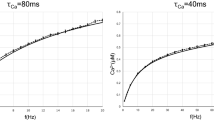Abstract
Spike-timing-dependent synaptic plasticity (STDP) is a simple and effective learning rule for sequence learning. However, synapses being subject to STDP rules are readily influenced in noisy circumstances because synaptic conductances are modified by pre- and postsynaptic spikes elicited within a few tens of milliseconds, regardless of whether those spikes convey information or not. Noisy firing existing everywhere in the brain may induce irrelevant enhancement of synaptic connections through STDP rules and would result in uncertain memory encoding and obscure memory patterns. We will here show that the LTD windows of the STDP rules enable robust sequence learning amid background noise in cooperation with a large signal transmission delay between neurons and a theta rhythm, using a network model of the entorhinal cortex layer II with entorhinal-hippocampal loop connections. The important element of the present model for robust sequence learning amid background noise is the symmetric STDP rule having LTD windows on both sides of the LTP window, in addition to the loop connections having a large signal transmission delay and the theta rhythm pacing activities of stellate cells. Above all, the LTD window in the range of positive spike-timing is important to prevent influences of noise with the progress of sequence learning.






Similar content being viewed by others
References
Bi G, Poo M (1998) Synaptic modifications in cultured hippocampal neurons: dependence on spike timing, synaptic strength, and postsynaptic cell type. J Neurosci 18:10464–10472
Buzsáki G (1989) Two-stage model of memory trace formation: a role for “noisy” brain states. Neurosci 31:551–570. doi:10.1016/0306-4522(89)90423-5
Dickson CT, Magistretti J, Shalinsky MH, Fransén E, Hasselmo ME, Alonso A (2000) Properties and role of Ih in the pacing of subthreshold oscillations in entorhinal cortex layer II neurons. J Neurophysiol 83:2562–2579
Fransén E, Alonso A, Hasselmo ME (2002) Simulations of the role of the muscarinic-activated calcium-sensitive nonspecific cation current INCM in entorhinal neuronal activity during delayed matching tasks. J Neurosci 22:1081–1097
Fransén E, Alonso A, Dickson CT, Magistretti J, Hasselmo ME (2004) Ionic mechanisms in the generation of subthreshold oscillations and action potential clustering in entorhinal layer II stellate neurons. Hippocampus 14:368–384. doi:10.1002/hipo.10198
Gerstner W, Abbott LF (1997) Learning navigational maps through potentiation and modulation of hippocampal place cells. J Comput Neurosci 4:79–94. doi:10.1023/A:1008820728122
Igarashi J, Hayashi H, Tateno K (2007) Theta phase coding in a network model of the entorhinal cortex layer II with entorhinal-hippocampal loop connections. Cogn Neurodyn 1:169–184. doi:10.1007/s11571-006-9003-8
Lin YW, Yang HW, Wang HJ, Gong CL, Chiu TH, Min MY (2006) Spike-timing-dependent plasticity at resting and conditioned lateral perforant path synapses on granule cells in the dentate gyrus: different roles of NMDA and group I metabotropic glutamate receptors. Eur J Neurosci 23:2362–2374. doi:10.1111/j.1460-9568.2006.04730.x
Nishiyama M, Hong K, Mikoshiba K, Poo MM, Kato K (2000) Calcium stores regulate the polarity and input specificity of synaptic modification. Nature 408:584–588. doi:10.1038/35046067
O’Keefe J, Recce ML (1993) Phase relationship between hippocampal place units and the EEG theta rhythm. Hippocampus 3:317–330. doi:10.1002/hipo.450030307
Pei X, Bachmann K, Moss F (1995) The detection threshold, noise and stochastic resonance in the Fitzhugh-Nagumo neuron model. Phys Lett A 206:61–65. doi:10.1016/0375-9601(95)00639-K
Skaggs WE, McNaughton BL (1996) Replay of neuronal firing sequences in rat hippocampus during sleep following spatial experience. Science 271:1870–1872. doi:10.1126/science.271.5257.1870
Song S, Miller KD, Abbott LF (2000) Competitive Hebbian learning through spike-timing-dependent synaptic plasticity. Nat Neurosci 3:919–926. doi:10.1038/78829
Tsukada M, Aihara T, Kobayashi Y, Shimazaki H (2005) Spatial analysis of spike-timing-dependent LTP and LTD in the CA1 area of hippocampal slices using optical imaging. Hippocampus 15:104–109. doi:10.1002/hipo.20035
Wagatsuma H, Yamaguchi Y (2007) Neural dynamics of the cognitive map in the hippocampus. Cogn Neurodyn 1:119–141. doi:10.1007/s11571-006-9013-6
Wiesenfeld K, Moss F (1995) Stochastic resonance and the benefits of noise: from ice ages to crayfish and SQUIDs. Nature 373:33–36. doi:10.1038/373033a0
Yoshida M, Hayashi H (2004) Regulation of spontaneous rhythmic activity and organization of pacemakers as memory traces by spike-timing-dependent synaptic plasticity in a hippocampal model. Phys Rev E Stat Nonlin Soft Matter Phys 69:011910. doi:10.1103/PhysRevE.69.011910
Yoshida M, Hayashi H, Tateno K, Ishizuka S (2002) Stochastic resonance in the hippocampal CA3-CA1 model: a possible memory recall model. Neural Netw 15:1171–1183. doi:10.1016/S0893-6080(02)00092-8
Zhou Y-D, Acker CD, Netoff TI, Sen K, White JA (2005) Increasing Ca2+ transients by broadening postsynaptic action potentials enhance timing-dependent synaptic depression. Proc Natl Acad Sci USA 102:19121–19125. doi:10.1073/pnas.0509856103
Acknowledgments
The authors are grateful to Dr. Katsumi Tateno and Dr. Motoharu Yoshida for valuable comments on the manuscript. The authors are also grateful to Mr. Takeru Nishikawa for executing several simulations. This work was supported by the 21st Century Center of Excellence Program (Center #19), “World of Brain Computing Interwoven out of Animals and Robots,” granted to Kyushu Institute of Technology by MEXT of Japan, and KAKENHI (19500126) granted to one of the authors by JSPS.
Author information
Authors and Affiliations
Corresponding author
Rights and permissions
About this article
Cite this article
Hayashi, H., Igarashi, J. LTD windows of the STDP learning rule and synaptic connections having a large transmission delay enable robust sequence learning amid background noise. Cogn Neurodyn 3, 119–130 (2009). https://doi.org/10.1007/s11571-009-9076-2
Received:
Revised:
Accepted:
Published:
Issue Date:
DOI: https://doi.org/10.1007/s11571-009-9076-2




